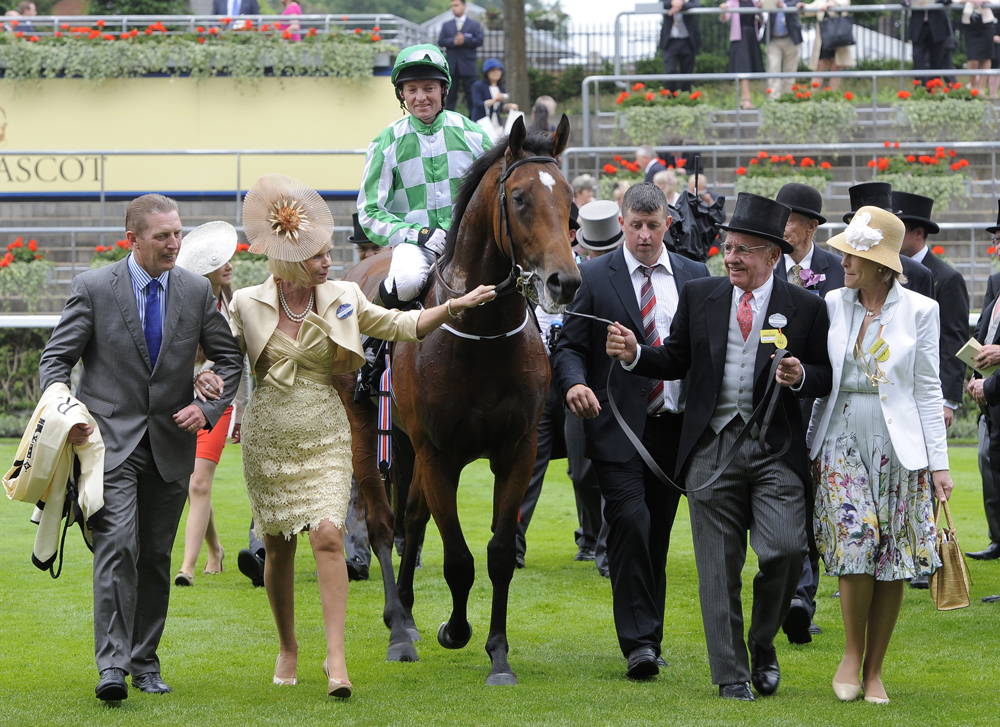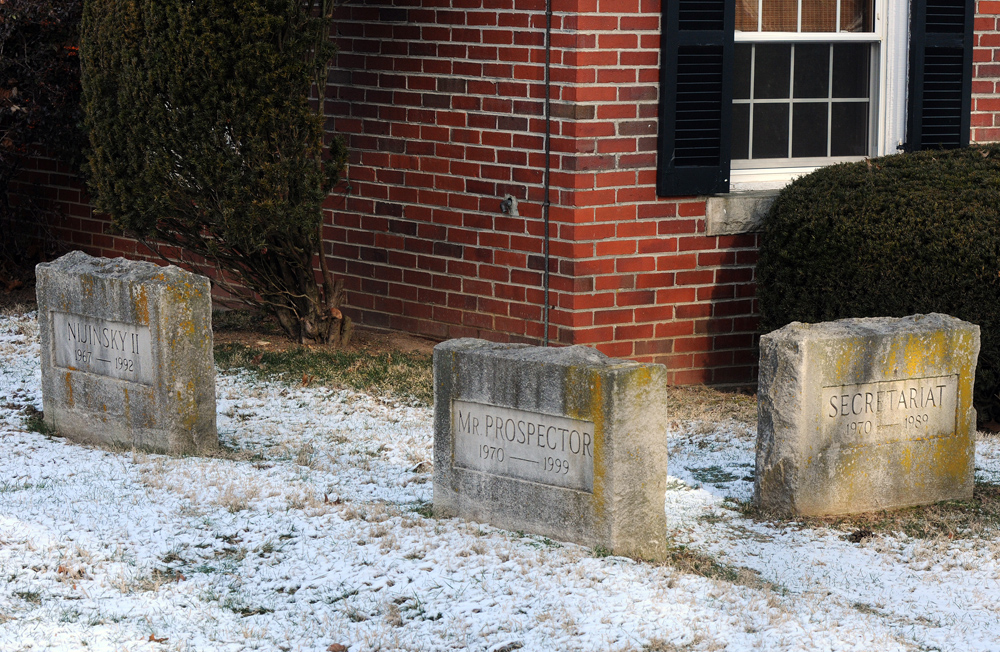Despite a marked physical similarity, when the Grade 2 winner War Front followed his sire, the mighty Danzig, to the stallion barn at Claiborne Farm in 2007, it would have been a case of hope over expectation that he would also follow the extraordinary stud career of his father, who had died the previous year.
“One of the reasons dad brought him back to the farm was that he was so much like Danzig,” says 24-year-old Walker Hancock, who is set to become the fourth generation of his family in charge of Claiborne when he takes over the running of the farm from his father Seth in the near future.
Bred and raced by Joseph Allen, War Front was raised at Claiborne, like so many of his contemporaries on the farm’s 12-strong stallion roster. Though he still has some way to go to emulate Danzig fully, the 12-year-old has made an eye-catching start, with five Grade or Group 1 winners to his name already – including, significantly, two in Europe – and at the time of writing he had already recorded two Grade 2 winners within the first fortnight of 2014. Such is the present clamour for nominations to War Front that his book – strictly limited to 100 mares – could easily be filled three times over, but it was a different story back in 2009.
“In his third season we sent out a letter that was sort of a begging letter trying to get people to breed to him,” recalls Claiborne’s Bloodstock Manager Bernie Sams. “I think that year he bred around 68 mares. But that was also the year he got Lines Of Battle, Jack Milton and Departing. In many ways it was probably his best book of mares as Seth had bred a number of good mares to him that year and so had Joe Allen.”
While the likes of The Factor, Summer Soiree, and Data Link had already signalled through top-level wins that War Front was a sire of serious note, 2013 was to prove a major breakthrough year on the international stage, the red-letter day coming on June 18 when his sons Declaration Of War and War Command secured a dream Group-race double at Royal Ascot. Both horses were bred by Allen and raced by him in partnership with the Coolmore team. Declaration Of War is now War Front’s first son to stand in Europe, under the Coolmore banner in Ireland.
Sams says: “The number of emails, texts and phone calls we all had that day was phenomenal. That probably did more for War Front to make him an international sire than if he’d had the Kentucky Derby winner.
“Coolmore have supported the horse – they started breeding mares to him in his fourth year at stud and since then they’ve been big supporters and own quite a few with Joe Allen. It’s been a good relationship for Claiborne too.
“There are a lot of European mares coming to Kentucky for him this year. My problem is I haven’t been able to take as many of them as I’d like to because he only breeds 100 mares and that’s it.”
In the age of colossal books, this refreshing policy isn’t restricted to War Front but is in place across the Claiborne roster.

War Command advertises his sire’s ability in Europe with victory at Royal Ascot
“The maximum for any stallion would be 120. Young horses like Orb, Data Link, Algorithms and Trappe Shot will breed 120 but the idea at that number is to be able to compete against other stallions who will have much bigger books,” Sams explains.
“As they get down the road and become proven we’ll try to take back a little bit and keep them to around 100. We breed War Front twice a day and that’s the book he gets.
“There are 40 shares, of which Mr Allen still owns significant interests, along with [Claiborne] farm. There are a few other share-holders but it’s a pretty tightly held syndicate. Most of the people in there are people who breed to race anyway, so I think as we go down the road there’ll probably be fewer offered as yearlings than in recent years. Previously he was a $15,000 stallion and there were a lot more commercial people who bred to him then.”
In fact, War Front has stood for as low as $10,000 in his fourth year at stud but that was also the year his first runners hit the track and since then his fee, like his reputation, has climbed annually. The annus mirabilis that was 2013 also saw Declaration Of War go on to capture the Juddmonte International after his Queen Anne Stakes victory, and War Command add the Dewhurst and Futurity to his Coventry Stakes win, while Derby wins (in Virginia, Illinois and the UAE) were provided by Departing, War Dancer and Lines Of Battle.
In the sales ring a War Front colt topped Keeneland September at $2.5 million and 43 of his yearlings sold for an average of $378,186 – another reason why he now commands a fee of $150,000, making him the most expensive stallion in the US along with Tapit, a son of the late Claiborne resident Pulpit.
History made and in the making
Of course War Front is merely the latest in a long line of illustrious names to have graced the stallion barns at the 3,000-acre farm in Paris, Kentucky, and relating his rise to prominence is only scratching at the surface of Claiborne’s rich history. Founded in 1910 by Arthur Boyd Hancock Sr, the farm received its first stallion, Wrack, in 1916. He was followed by the imported Poule d’Essai des Poulains winner Sir Gallahad III, sire of Triple Crown winner and fellow Claiborne sire Gallant Fox and the first of ten champion sires to stand at the farm. In 1949, Hancock was succeeded by his son, AB ‘Bull’ Hancock Jr, under whose reign Nasrullah was imported, future champion sires Bold Ruler and Round Table were born at the farm (on the same day) and English Triple Crown winner Nijinsky returned to North America to be syndicated by Claiborne.
At the age of 23, Seth Hancock, the younger of Bull’s two sons, took up the reins following the death of his father at just 47 and made his mark instantly by encouraging the farm’s clients to get involved in a stallion syndicate for the then-juvenile Secretariat. Walker Hancock has some big shoes to fill.

Nijinsky, Mr Prospector and Secretariat buried together at the Claiborne cemetery
In the graveyard behind the farm office – one of three equine cemeteries on the gently rolling property – are the headstones of 21 horses. Twenty of them were Claiborne stallions, including Nasrullah, his son Bold Ruler and grandson Secretariat, whose damsire Princequillo is also nearby. The deeds of that quartet alone are enough to fill several history books, but alongside Secretariat in this revered corner of horse heaven is found Mr Prospector and next to him, Nijinsky. The only non-stallion among them is Swale, Seth Hancock’s homebred Kentucky Derby and Belmont Stakes winner who collapsed and died just eight days after his 1984 Belmont victory.
But Claiborne’s heritage is far from being all about the stallions. In the Marchmont Cemetery is buried Personal Ensign, one of the most talented racemares of all time with 13 unbeaten starts to her name. Her genetic superiority was such that she produced three Grade 1 winners and was Broodmare of the Year in 1996. She was one of the jewels of the Phipps family’s broodmare band, which resides at Claiborne and marks a long association between two racing families. The Hancocks’ long established partnerships with prominent fellow breeders who remain as clients has not only seen reflected glory for Claiborne on the racecourse but has also aided its mission of securing a plethora of well-credentialed stallions.
The Phipps family’s influence is evident again in one of Claiborne’s new recruits for this season, the Kentucky Derby winner Orb. Bred by Ogden Mills ‘Dinny’ Phipps with his cousin Stuart Janney III, the son of Malibu Moon was another to have been foaled at Claiborne and later return triumphant.
“It’s always great to have a Derby winner come to the farm, especially one who’s been raised here and one that has the history of going back through the Janney and Phipps families and their longstanding relationship with Claiborne Farm,” says Sams.
“It was fantastic even to have the horse win the Derby for those connections. For this country it’s pretty much what it’s all about.
“If you look at the stallion roster here now, Arch was bought as a yearling, Blame was raised here, Flatter was raised here, along with Orb, Stroll, Horse Greeley, Parading, War Front. Really the only outside horses are First Samurai – but he belonged to Bruce Lunsford, who has mares here – and Trappe Shot belonged to Mr Brady who’s been a long-time client of Claiborne.”
And it’s not only the equine lines that have longevity at Claiborne. Current general manager Bradley Purcell was born and bred at the farm, his father Billy having been a broodmare foreman for decades, and it’s a similar story for many of his co-workers.
Sams adds: “For the guys out on the farm to raise those horses, see them leave, run like they have and come back as stallions, it’s great.”
Marchmont’s hallowed grounds also contain a mare who could hardly have been better named when one considers her impact on the breed: Special. A grand-daughter of Rough Shod, who was bought in England by Bull Hancock in 1951, Special, as the dam of Nureyev and grandam of Sadler’s Wells, has played a significant role in extending the Claiborne influence on a global scale, and that could expand yet further through her great grandson, Blame.
Famed as the sole conqueror of Zenyatta, Blame’s six Graded stakes victories included the Fayette Stakes at Keeneland in 2009, in which he was chased home by his fellow Claiborne graduate Parading, a great grandson of Personal Ensign who has followed his sire Pulpit to stand on the Claiborne roster. Like Blame, he has his first runners this year. That continuity is echoed by the second new stallion at the farm for 2014, War Front’s Grade 1 winner Data Link, bred and owned by Stuart Janney.
The modern-day norm – shuttle stallions, big books of mares, state-of-the-art covering sheds – is eschewed for more traditional ways at Claiborne
Claiborne’s motto is ‘Doing the usual unusually well’. It’s a slogan which can be read as both modest and boastful, and its paradoxical nature strikes at the very essence of the farm itself. No imposing gates or signs adorn the entrance; the small office is homely rather than flashy. The only hint at the high-grade operation conducted within its walls are the leather headcollars which hang there, bearing brass nameplates to make racing historians go weak at the knees: Buckpasser, Herbager, Easy Goer, Damascus, Danzig, Mr Prospector. The list goes on.
The modern-day norm – shuttle stallions, big books of mares, state-of-the-art covering sheds – is eschewed for more traditional ways, but then the old covering shed has served the farm very well, with six of the 11 American Triple Crown winners having been conceived within, while ten Kentucky Derby winners have been raised at Claiborne.
The stallions, without rugs, their coats naturally long in midwinter, are allowed just to be horses for as much time as is naturally possible on a farm which is about to head into its busiest period. The mares, precious as many of them are, mostly foal down in the paddocks.
When interviewed for a centenary feature in the Blood-Horse in 2010, Seth Hancock, who has steadfastly stuck to his guns over the farm’s traditional approach to breeding and rearing thoroughbreds, admitted: “There is pressure; I’d be lying if I said there wasn’t. This place has been a going concern for a long, long time. We have ten stallions here now; the oldest is just 16, so our roster is young, though it’s obviously not as strong as it was when I took over. Pulpit is terrific, and we’re excited about First Samurai and War Front and Flatter. Hopefully Blame will come back here and the playing field will level out so we can compete for some of these big-time horses again.
“I have no regrets. We’ve done everything we can do to try to position ourselves for the future, and I think we are well-positioned. Having said that, we still need to have some things happen.”
Pulpit died in 2012 but has provided the Claiborne roster with two sons and a grandson. Blame is back and War Front has happened. In the meantime, Claiborne has continued to do business as usual. That is to say, unusually well.



